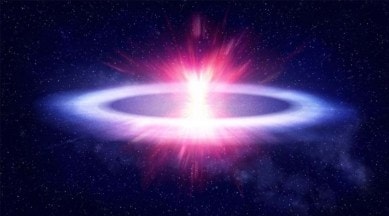Astronomers discover flattest explosion ever seen in space
Astronomers are trying to understand how an explosion in space turned out to be flat like a pancake, instead of spherical, like they usually are.

An explosion that happened over 180 million light-years away from us is baffling scientists. The reason? It seems to be as flat as a pancake.
Stars are spherical in shape. And, when stars explode in the universe, the explosions themselves are usually spherical. But according to the University of Sheffield, this particular explosion is the most aspherical one ever seen in space. It is shaped almost like a disc.
monthly limit of free stories.
with an Express account.
The explosion has been classified as a Fast Blue Optical Transient (FBOT), which is an extremely rare class of explosion that is much less common than other kinds. The first bright FBOT was discovered in 2018 and was nicknamed the cow. Including the explosion discovered in 2018, and the latest one, only a total of five FBOTs have been discovered.
Scientists are still not sure about how bright FBOT explosions occur but this new observation, published in the Monthly Notices of the Royal Astronomical Society, could help them understand the rare phenomena better.
“Very little is known about FBOT explosions – they just don’t behave like exploding stars should, they are too bright and they evolve too quickly. Put simply, they are weird, and this new observation makes them even weirder,” said Justyn Maund, lead author of the study, in a press statement. Maund works at the University of Sheffield’s Department of Physics and Astronomy.
According to Maund, there are a few plausible explanations for the disc-like explosion. The stars involved in the explosion could have created the disc just before they died, or maybe, they could have been failed supernovas where the core of the star collapsed into a black hole, consuming the rest of the star.
As per the University of Sheffield, this discovery was made completely by chance. The scientists spotted a flash of polarised light and they were able to measure the polarisation of the blast. They used the Liverpool Telescope and the astronomical equivalent of polaroid glasses to make the observations.
They measured the polarisation of the collected data. They reconstructed the 3D shape of the explosion using this data and were able to map the edges of the blast, which is when they saw just how flat it was.
Now, the researchers plan to conduct more surveys of such celestial outliers with the Vera Rubin Observatory in Chile, hoping to discover more FBOTs to further understand them.